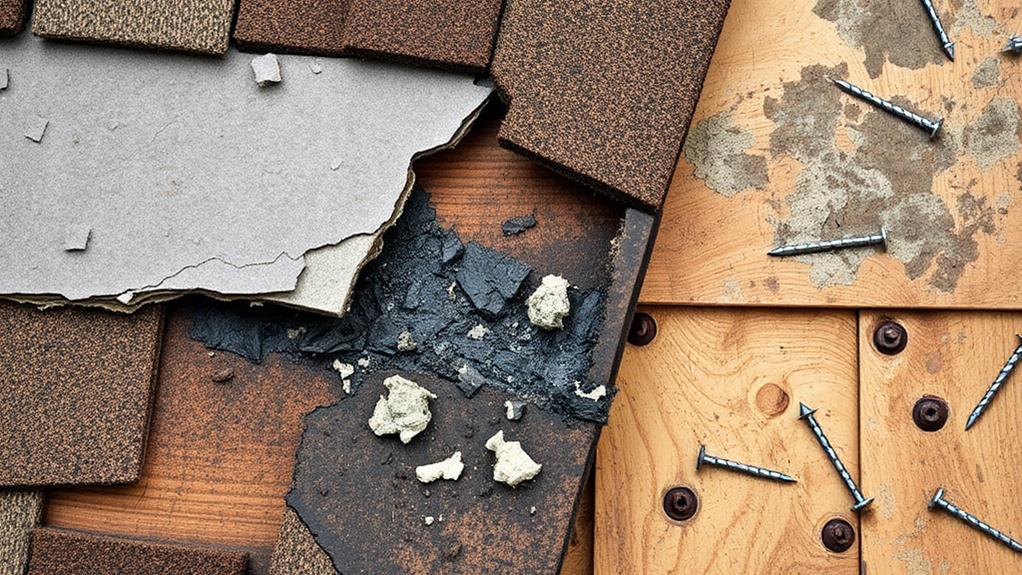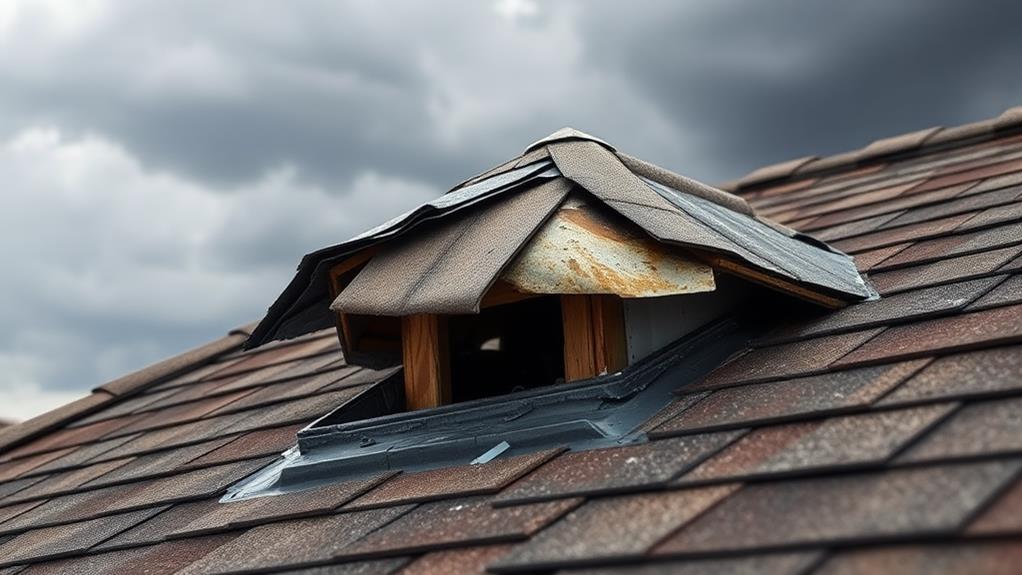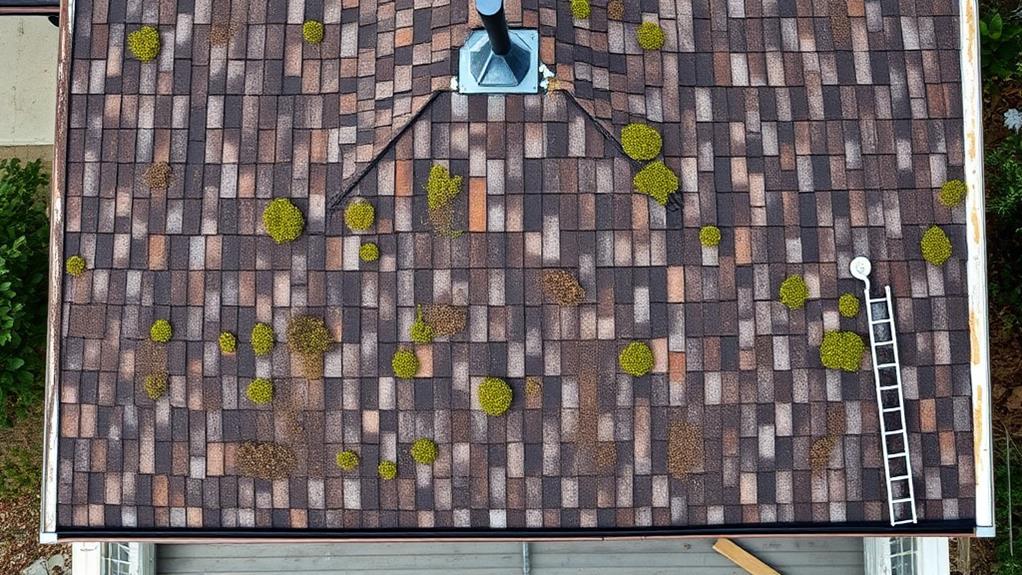Storm damage to a roof extends far beyond visible shingle issues, affecting the entire roofing system. Underlayment can deteriorate, compromising water resistance. Flashing and sealants may become damaged, leading to leaks. Ventilation systems can be disrupted, causing heat and moisture buildup. Decking and structural components might suffer from warping or cracking. Gutters and drainage systems can be compromised, potentially causing water backup. Hidden damage can occur within the roof structure, leading to long-term problems if left unaddressed. Understanding these comprehensive effects is crucial for maintaining your roof's integrity and preventing costly repairs. Exploring each aspect reveals the importance of thorough post-storm inspections.
Underlayment Deterioration

One of the less visible but potentially serious consequences of storm damage to your roof is underlayment deterioration. The underlayment is a crucial protective layer installed beneath the shingles, serving as a secondary barrier against moisture infiltration. During severe storms, high winds can lift shingles, exposing the underlayment to direct impact from rain, hail, and debris.
Prolonged exposure to these elements can cause the underlayment to weaken, tear, or develop small holes. This damage compromises its ability to repel water, leading to potential leaks and moisture intrusion into the roof structure. Additionally, UV radiation from extended sun exposure can accelerate the breakdown of certain underlayment materials, particularly if they're left uncovered for extended periods after shingle damage.
Signs of underlayment deterioration may include water stains on ceilings, damp insulation in the attic, or visible sagging of the roof deck. It's crucial to have a professional roofing inspection following severe storms, as underlayment damage is often not visible from the ground. Timely detection and repair of underlayment issues can prevent more extensive and costly damage to your home's structure and interior.
Flashing and Sealant Damage
Storms can wreak havoc on your roof's flashing and sealants, compromising critical waterproofing components. Flashing, typically made of metal or rubber, seals vulnerable areas like chimneys, vents, and roof valleys. High winds, hail, and debris can dent, lift, or tear flashing, creating entry points for water.
Similarly, sealants used around roof penetrations and along edges can deteriorate or separate during severe weather.
Damaged flashing may not be immediately visible from the ground, making professional inspection crucial after major storms. Signs of compromised flashing include water stains on ceilings or walls near roof features, rust streaks on exterior walls, or visible gaps between flashing and roofing materials. Sealant damage often manifests as cracking, shrinking, or complete separation from the applied surface.
Prompt repair of flashing and sealant issues is essential to prevent water infiltration and subsequent structural damage. This may involve replacing damaged flashing sections, resealing joints, or applying new sealant where needed. Regular maintenance and timely storm damage assessments can help identify and address these issues before they lead to more extensive and costly repairs.
Ventilation System Compromises

Powerful storms can severely impact your roof's ventilation system, compromising its ability to regulate temperature and moisture. High winds can damage or dislodge ridge vents, soffit vents, and gable vents, disrupting proper airflow throughout the attic space. Debris carried by storm winds may clog these ventilation openings, further reducing their effectiveness.
Storm-related ventilation damage can lead to a host of problems for your home. Inadequate airflow can cause heat and moisture to build up in the attic, potentially leading to mold growth, wood rot, and reduced insulation efficiency. This can result in higher energy costs and decreased comfort inside your home.
Additionally, poor ventilation can contribute to ice dam formation in colder climates, as heat trapped in the attic melts snow on the roof, which then refreezes at the eaves.
To assess ventilation damage after a storm, inspect your roof for missing or damaged vents, debris accumulation around ventilation openings, and signs of water intrusion in the attic. Promptly addressing these issues by repairing or replacing damaged components is crucial to maintaining your roof's integrity and your home's overall energy efficiency.
Decking and Structural Issues
The foundation of your roof's integrity lies in its decking and structural components, which can suffer significant damage during severe storms. High winds, heavy rain, and flying debris can compromise the roof's underlying structure, often in ways not immediately visible from the ground.
Decking, typically made of plywood or oriented strand board (OSB), provides the base for roofing materials. Storm damage can cause decking to warp, rot, or develop cracks. Water infiltration through compromised shingles or flashing can lead to moisture damage, weakening the decking over time. In extreme cases, large tree limbs or other debris may puncture the decking, creating immediate structural vulnerabilities.
Roof trusses and rafters, which form the skeleton of the roof, can also sustain damage during storms. High winds may cause these components to shift, crack, or even break. This structural damage can lead to sagging areas on the roof, compromised load-bearing capacity, and potential collapse if left unaddressed. Additionally, moisture intrusion can cause wood rot in these crucial structural elements, further undermining the roof's integrity and potentially affecting the entire building's structural stability.
Gutter and Drainage Problems

A roof's defense system against water damage relies heavily on its gutters and drainage components. During severe storms, these crucial elements can sustain significant damage, compromising the entire roof's integrity. High winds may dislodge or bend gutters, while debris carried by storm winds can clog downspouts and cause water to back up.
Hail can dent or puncture gutters, reducing their effectiveness in channeling water away from the roof and foundation. Additionally, the weight of accumulated ice or snow can cause gutters to sag or pull away from the roofline, creating gaps where water can seep into the fascia and soffit. Improper drainage can lead to water pooling on the roof, potentially causing leaks and accelerating shingle deterioration.
Storm damage to gutters and drainage systems may not be immediately apparent, but its effects can be far-reaching. Water overflow from damaged gutters can erode the soil around the foundation, potentially leading to structural issues. Regular inspection and prompt repairs of storm-damaged gutters and drainage components are essential to maintain the roof's overall health and prevent costly water damage to both the exterior and interior of the home.
Identifying Hidden Storm Damage
While visible storm damage often demands immediate attention, hidden issues can be equally detrimental to a roof's integrity. These concealed problems may not manifest immediately but can lead to significant structural damage over time. Homeowners should be vigilant in identifying subtle signs of storm damage, such as small cracks in flashing, slight indentations on shingles, or minor separation of roofing materials.
Interior inspections can reveal hidden storm damage through water stains on ceilings, walls, or in the attic. Musty odors or increased humidity levels may indicate water infiltration. Exterior examinations should include checking for granules in gutters, which can signify shingle deterioration. Carefully inspect soffit and fascia boards for signs of water damage or rot.
Professional roof inspections are crucial after severe weather events, as trained experts can detect issues invisible to the untrained eye. They may use specialized equipment like infrared cameras to identify areas of moisture accumulation within the roofing system. Addressing hidden storm damage promptly can prevent more extensive and costly repairs in the future, ensuring the longevity and effectiveness of your roof's protective function.
Long-Term Effects of Neglect

Frequently, neglecting storm damage to a roof can lead to severe and costly consequences over time. What may begin as minor issues can rapidly escalate into major structural problems if left unaddressed.
Water infiltration through small leaks can cause wooden roof components to rot, compromising the integrity of the entire structure. This moisture can also lead to mold growth, potentially causing health hazards for occupants.
Unrepaired damage to shingles or flashing can worsen with subsequent weather events, allowing more water to penetrate the roof system. This can result in damage to insulation, reducing energy efficiency and increasing utility costs. The added weight of water-saturated materials can strain roof trusses and other supporting structures, potentially leading to sagging or even collapse in extreme cases.
Moreover, neglected storm damage can void manufacturer warranties and insurance coverage, leaving homeowners fully responsible for costly repairs or replacements. Regular inspections and prompt repairs following storms are crucial to maintaining roof integrity, preventing long-term damage, and ensuring the safety and comfort of the home's inhabitants.
Frequently Asked Questions
How Often Should I Have My Roof Professionally Inspected?
Professional roof inspections are recommended annually, or after severe weather events. Homeowners should also perform visual checks twice a year. Regular inspections help identify potential issues early, preventing costly damage and extending the roof's lifespan.
Can I Claim Storm Damage on My Homeowner's Insurance?
Yes, you can typically claim storm damage on your homeowner's insurance. However, coverage depends on your specific policy and the extent of the damage. Document the damage thoroughly and contact your insurance provider promptly to initiate the claims process.
What's the Average Lifespan of Different Roofing Materials?
The average lifespan of roofing materials varies significantly. Asphalt shingles typically last 20-30 years, metal roofs 40-70 years, clay tiles 50-100 years, and slate can exceed 100 years. Factors like climate and maintenance affect longevity.
How Can I Prevent Ice Dams From Forming on My Roof?
To prevent ice dams, ensure proper attic insulation and ventilation, clean gutters regularly, and use heated cables on roof edges. Installing a water-repellent membrane under shingles and removing snow promptly can also help mitigate ice dam formation.
Are There Eco-Friendly Options for Roof Repair and Replacement?
Yes, eco-friendly options for roof repair and replacement exist. These include recyclable materials like metal roofing, sustainable wood shingles, and solar tiles. Cool roofing products and green roofs are also environmentally conscious choices for homeowners seeking sustainable alternatives.
Conclusion
A comprehensive understanding of storm damage extends far beyond visible shingle issues. As the adage goes, "An ounce of prevention is worth a pound of cure." Regular roof inspections and prompt repairs are crucial for maintaining the integrity of the entire roofing system. Neglecting hidden damage can lead to costly long-term consequences, affecting not only the roof but also the structural integrity of the building. Addressing all components, from underlayment to ventilation, ensures a robust defense against future storms.

